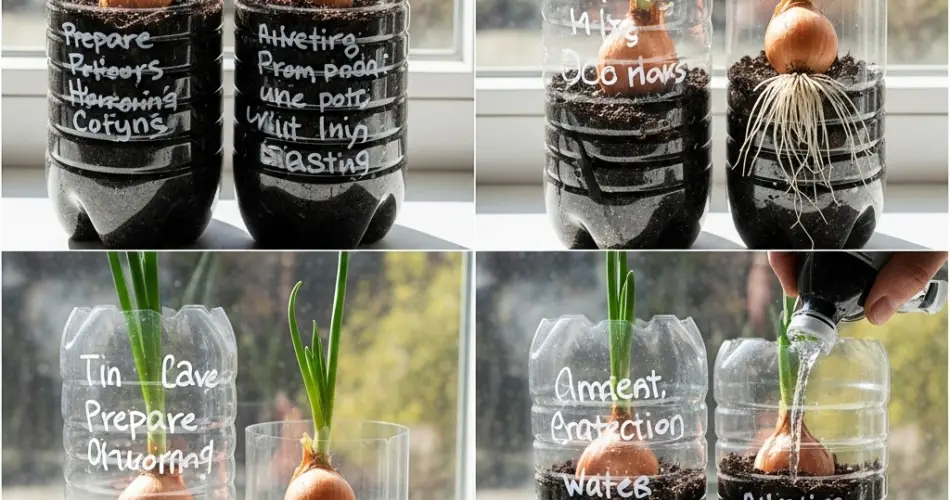If you’ve ever tossed out the end of an onion, you’ve missed an opportunity to regrow a fresh supply at home—no garden required. With just a plastic bottle and a little water or soil, you can turn onion scraps into thriving plants. This simple and sustainable method is ideal for small spaces like windowsills, balconies, or kitchen counters. Whether you prefer growing in water for convenience or soil for a longer-term harvest, both approaches are easy to follow and require minimal effort.
Why Regrow Onions in Bottles?
Plastic bottles are practical containers for urban gardening. They’re compact, easy to find, and help reduce plastic waste. When growing onions, bottles allow for clear observation of root development and offer good moisture control. Plus, regrowing onions is a great way to save money, reduce food waste, and keep a steady supply of fresh greens or bulbs right at home.
This method works well with green onions (scallions), spring onions, or even bulb onions if you’re patient enough. Both water and soil propagation are viable options depending on your goal—quick green shoots or full-sized bulbs.
Materials You’ll Need
To start regrowing onions, gather the following:
-
A clean plastic bottle (1.5 to 2 liters is ideal)
-
Scissors or a craft knife
-
Onion bottoms (2–3 cm of the base with roots or sprouting centers)
-
Potting soil (for the soil method)
-
Clean water (for the water method)
-
Toothpicks (optional for water method)
-
Spray bottle or watering can
Method 1: Regrowing Onions in Water
Step 1: Prepare the Bottle
Cut the top off the plastic bottle to make it easy to insert and remove onion bases. If you’re using toothpicks to suspend the onions, you can keep the bottle intact and fill it with water, leaving space at the top for the onion base to sit above water.
Step 2: Prep the Onion Base
Use onion scraps that still have visible roots or a small green sprout in the center. Rinse them gently and trim any dry or damaged layers.
Step 3: Position the Onion
Place the onion base over the bottle opening, ensuring only the root area touches the water. If the bottle opening is too wide, use toothpicks inserted on the sides of the onion to hold it up.
Step 4: Maintain Water and Light
Change the water every 2 to 3 days to prevent rot and bacteria. Place the bottle in a sunny location, such as a windowsill, where it can receive at least 6 hours of indirect sunlight.
Step 5: Watch It Grow
In just a few days, green shoots will start to emerge. You can begin harvesting the greens once they reach about 15 cm tall by snipping the tops. The onion will continue to produce more shoots as long as the base stays healthy.
While this method doesn’t grow large bulbs, it’s great for an ongoing supply of fresh onion greens.
Method 2: Regrowing Onions in Soil
Step 1: Prepare the Bottle
Cut the bottle horizontally about two-thirds up from the base. Poke small holes in the bottom for drainage. You can also cut small holes along the sides if you want to plant multiple onions in one vertical container.
Step 2: Fill with Soil
Add a layer of well-draining potting soil or compost. Gently moisten the soil before planting.
Step 3: Plant the Onion Base
Place the onion base into the soil with the root side down and the cut side just at or slightly above the surface. Lightly press the soil around it to hold it in place.
Step 4: Provide Sunlight and Water
Position the bottle in a bright area where the plant can get at least 6 hours of light daily. Water consistently to keep the soil moist but not soggy.
Step 5: Growth and Harvest
Shoots will begin to grow in about a week. If left long enough, the onion can form new bulbs. This method allows for more complete regrowth compared to water-only propagation.
When shoots reach a good height, you can start harvesting the greens, leaving at least 5 cm of growth so the plant can regenerate. If you’re aiming to harvest the bulb, wait until the tops start to yellow and fall over—this signals maturity.
Tips for Success
-
Use organic or untreated onions when possible. Some store-bought onions are treated with anti-sprouting agents.
-
Don’t overcrowd bottles; give each onion space for root and shoot development.
-
Regularly check for mold, rot, or pests, especially in humid environments.
-
Label your bottles if growing different varieties to track performance and flavor.
Final Thoughts
Regrowing onions in plastic bottles using water or soil is a smart, eco-friendly way to keep your kitchen stocked with fresh ingredients. It’s easy enough for beginners and efficient for those short on space. Whether you’re after a quick supply of green shoots or planning to grow full bulbs, this method offers a sustainable and rewarding gardening experience right from your windowsill.



